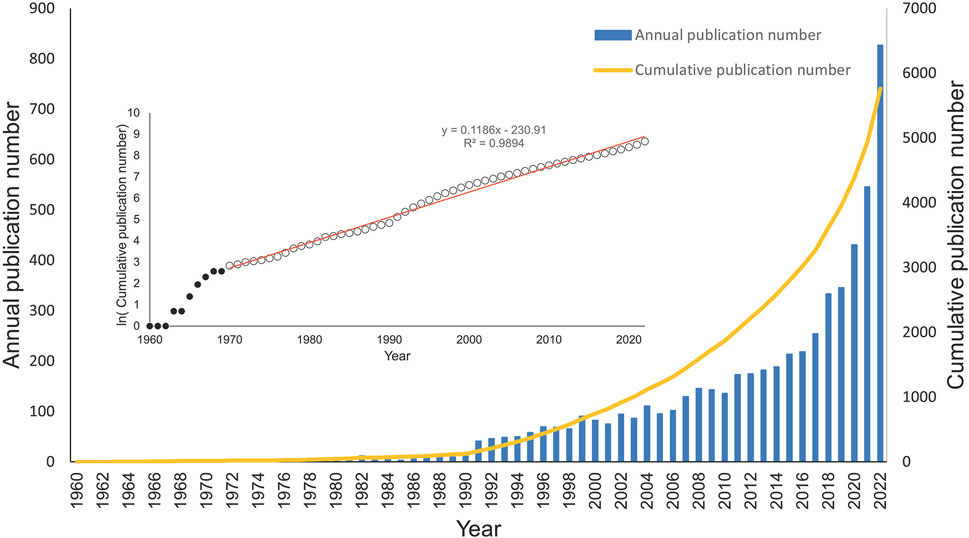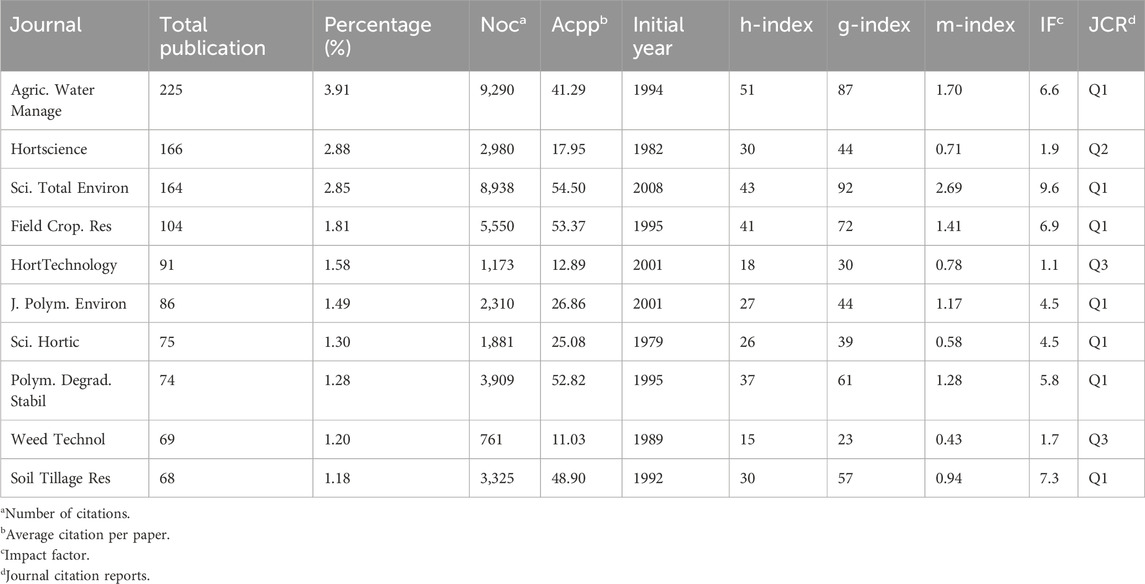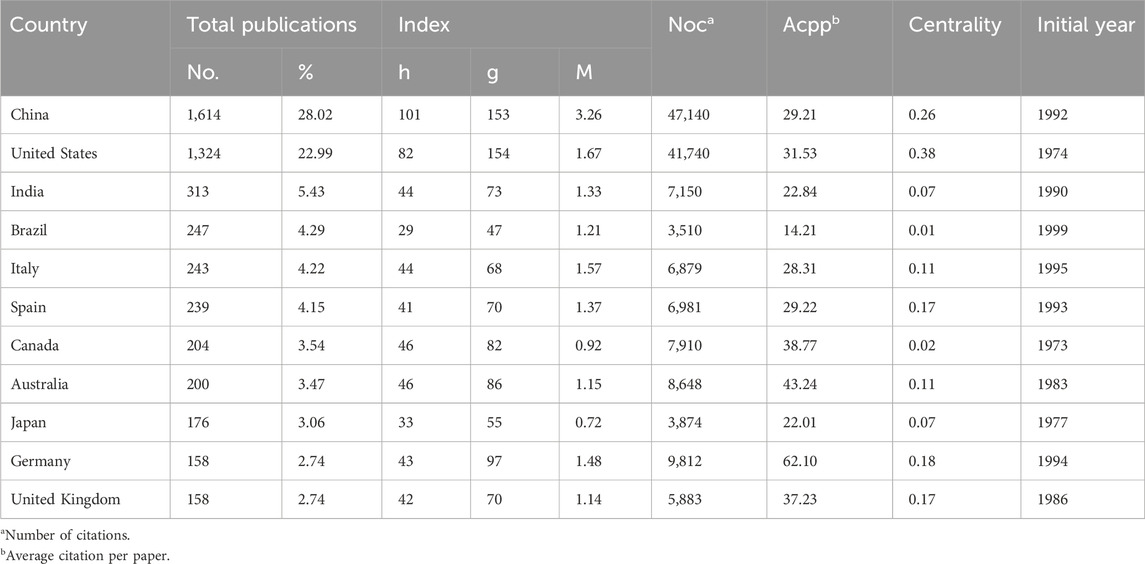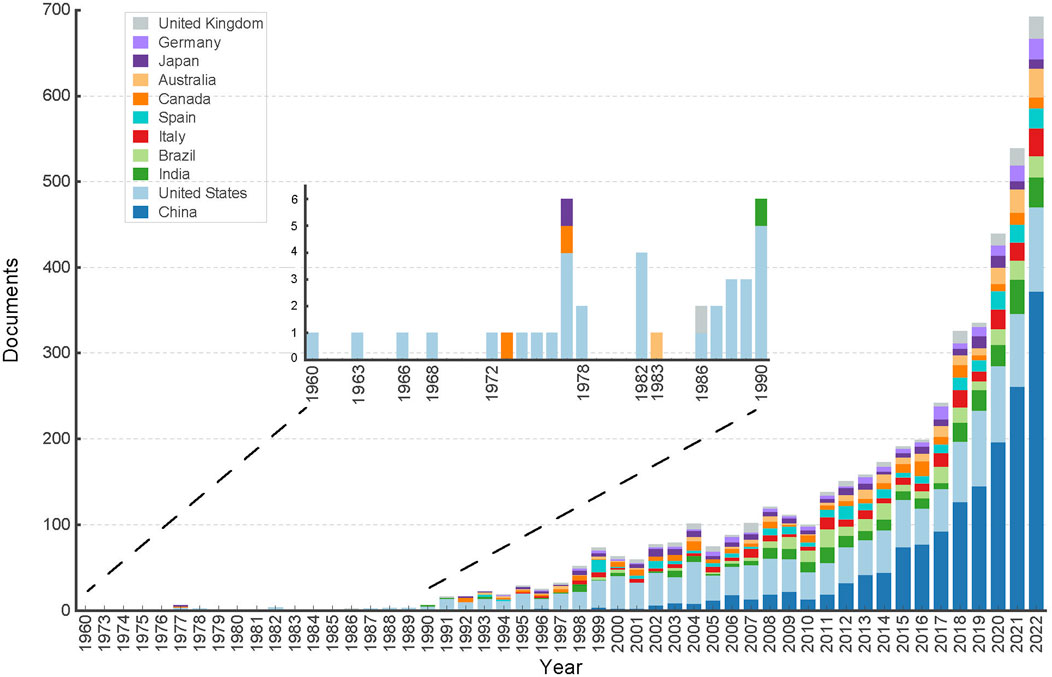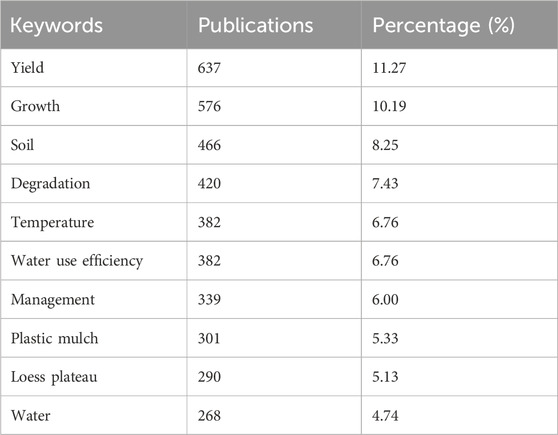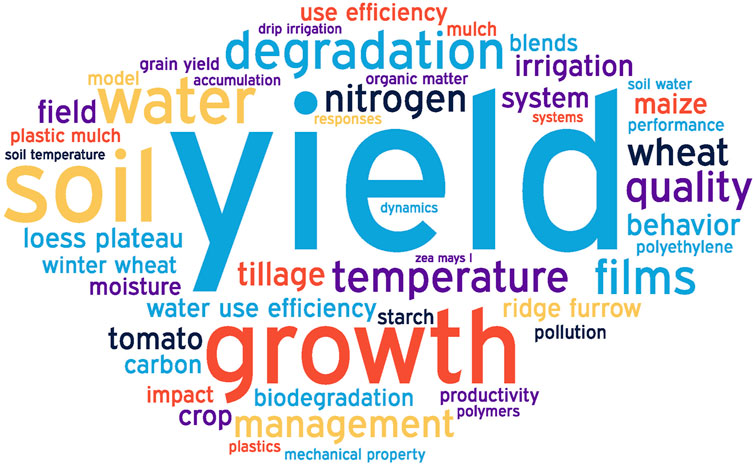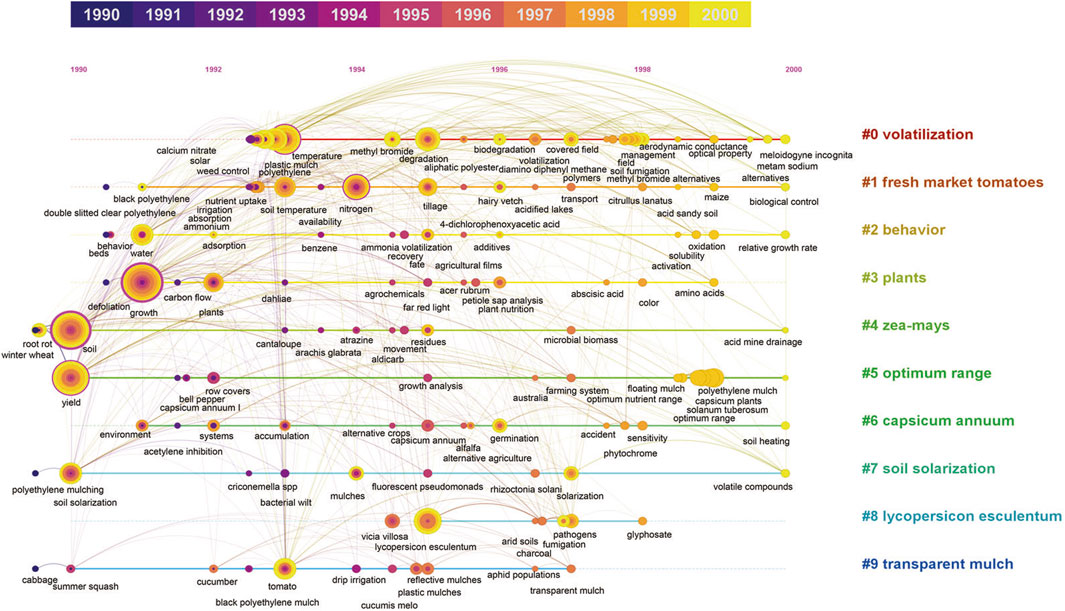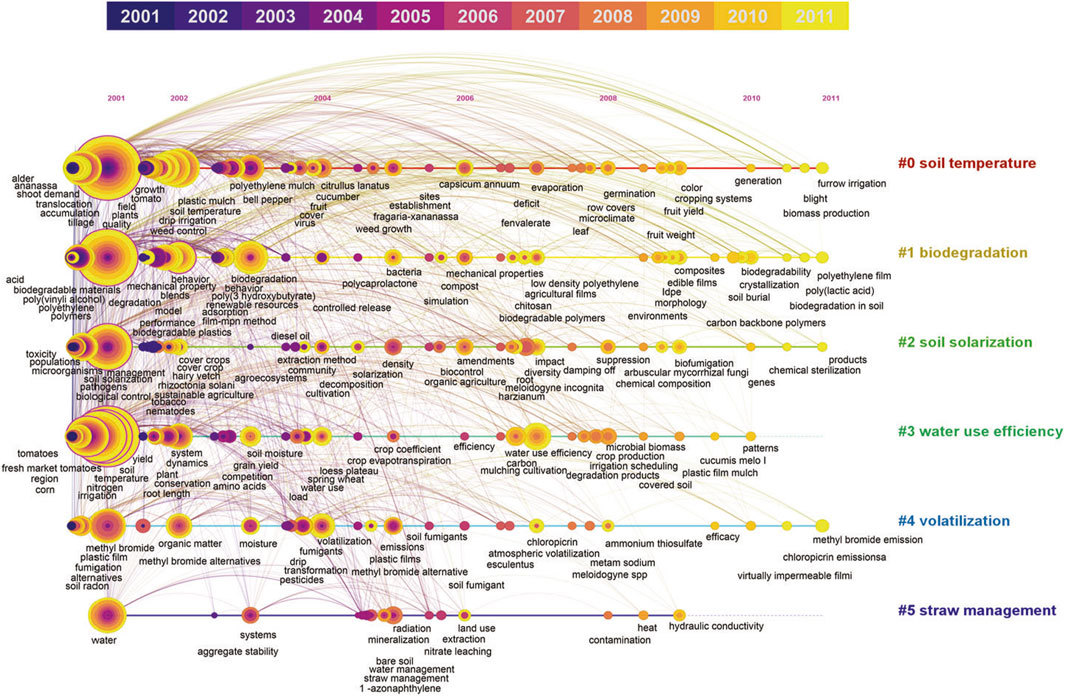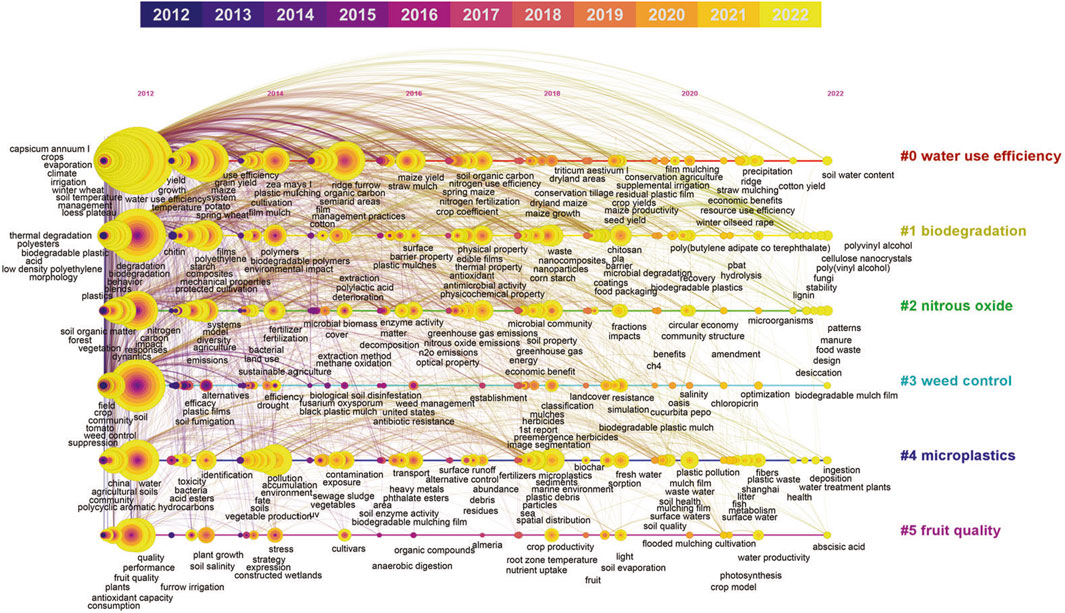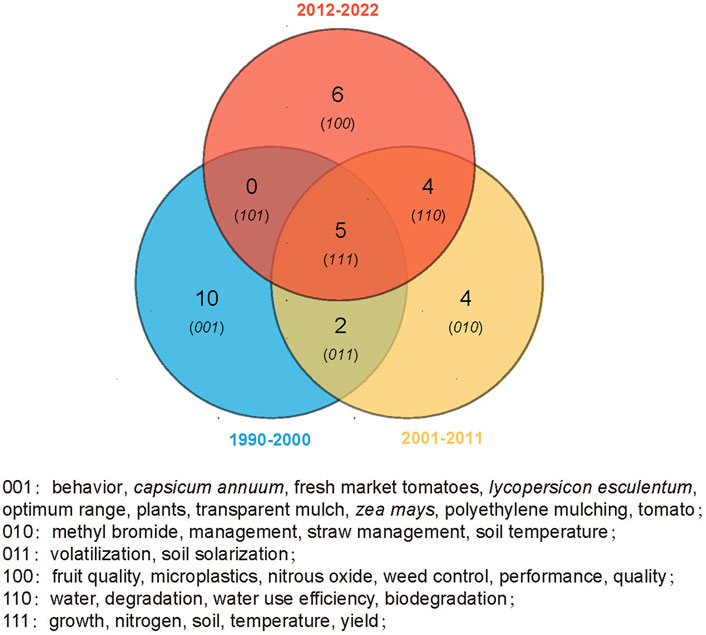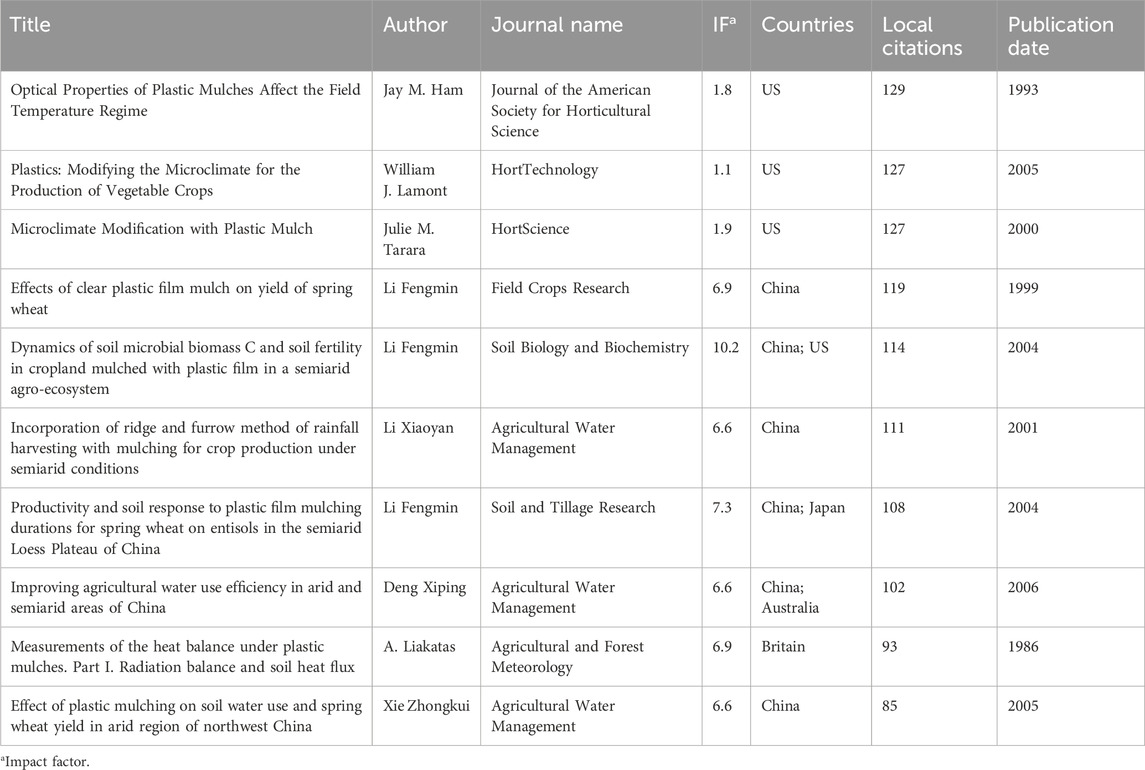Evolution of hotspots and research trends in agricultural mulch film research: a bibliometric review
- 1Hunan Engineering and Technology Research Centre for Agricultural Big Data Analysis and Decision-Making, Hunan Agricultural University, Changsha, China
- 2Rural Energy and Environment Agency, Ministry of Agriculture and Rural Affairs, Beijing, China
- 3College of Resources, Hunan Agricultural University, Changsha, China
Agricultural mulch film (AMF) can increase the soil temperature, reduce the evaporation of water and soil erosion, control the number of weeds and pests, and improve the yield and quality of crops. However, the environmental pollution caused by AMF residues is becoming serious and has attracted increasing amounts of research. Research on AMF is a complex subject with diverse content and rich perspectives. Currently, there have been few systematic reviews of the use of AMF. To comprehensively and deeply understand the current status, hotspots, and trends of research on AMF, this paper conducted a bibliometric analysis of AMF literature from 1960 to 2022. Results are as follows: the overall publication volume in the field of AMF has increased 1960 to 2022. The top three countries contributing to publication volume include China, United States (US) and India, which are also the main collaborating nations. Notably, cooperation between China and US is the most frequent, and a cluster constituted by European nations serve as a primary collaborator for other countries. Owing to the introduction and development of the concept of degradable plastics, the field entered a period of rapid growth after 1970 and has primarily focused on continuous development in the areas of horticulture and environmental science. Current research on AMF primarily aims to: 1) develop applications that are aimed at enhancing the yield and quality of crops, and 2) improve the materials used to produce AMF to reduce its environmental impact. The persistent hotspots of research in AMF revolve around modifying the soil microclimate, promoting crop growth and development, and increasing crop yields. Frontier AMF research includes: exploring crop quality enhancement mechanisms, developing low-cost biodegradable film technologies and their natural degradation effects, and investigating AMF’s impact on soil nitrous oxide emissions and associated mechanisms.
1 Introduction
The rapid expansion of the population presents a substantial challenge to the adoption of effective and sustainable agricultural practices, given the constraints of limited arable land (Kahraman et al., 2022). Agricultural mulch film (AMF) can increase the soil temperature, reduce the evaporation of soil moisture and erosion, prevent the soil from splashing onto fruits or vegetables, aid in weed and pest control (Sintim and Flury, 2017), and significantly shorten the time of development of seeds and fruits (Steinmetz et al., 2016). These benefits enhance the yield and quality of crops, which results in its use as a rapidly advancing and widely adopted technology in agriculture.
The materials and negative impact of AMF on soil nutrients has attracted global attention. The composition of AMF varies. Early versions were primarily made of low-density polyethylene (PE), which is not easily biodegradable. Owing to frequent soil contamination and easy breakage, PE mulch film is rarely recycled. As a result, it is often abandoned in the soil or directly burned in the fields, which lead to severe environmental pollution. PE mulch film in the soil degrades into fragments, and these fragments break down further into microplastics. Crops, such as wheat (Triticum aestivum) and lettuce (Lactuca sativa), can absorb microplastics through their cracks (Li et al., 2020). Therefore, microplastics can be transferred to the human body through crops, which poses a threat to human health, and plastic fragments from all sources ultimately accumulate in the oceans (Zhou et al., 2022), which endangers the entire ecosystem. When residual mulch film is burned, it generates organic pollutants, such as furans and dioxins, that cause atmospheric pollution (Jayasekara et al., 2005). Dioxins, in particular, are highly carcinogenic and can disrupt the function of endocrines within the body (Wang et al., 2023). Numerous studies have investigated the use of AMF from an environmental perspective (Kasirajan and Ngouajio, 2012; Qi et al., 2020; Menossi et al., 2022). To reduce their environmental impact, subsequent developments include the use of polylactic acid (PLA), polybutylene succinate (PBS), polyethylene succinate (PES), thermoplastic starch (TPS), and various mixed-material mulch films. While AMF enhances crop productivity, it increases the biological degradation of crop residues and the soil organic matter. This is considered a trigger for the rapid depletion of soil nutrients, particularly carbon reserves, which can potentially lead to a decrease in soil quality and hinder the soil’s ability to serve its intended purposes (Domagała-Świątkiewicz and Siwek, 2013; Zhang et al., 2015).
The global usage of greenhouse film and mulching increased from 4.4 million tons in 2012 to 7.4 million tons in 2019, which represents an increase of 69% (Somanathan et al., 2022). China has the largest coverage system for AMF in the world. In 2018, the consumption of PE mulch film reached 1.4 million tons and covered an area that exceeded 17.8 million ha and constituted 15% of the nation’s arable land (Liu et al., 2021). Properly managing the environmental pollution caused by PE mulch film is crucial for China and the global community. Understanding the current environmental impact of AMF and identifying other critical issues that urgently require solutions is essential. A comprehensive understanding of the status of current research and frontier directions regarding AMF is necessary to address and resolve these issues. Owing to the complexity of the research object, diverse study contents, and rich perspectives in AMF research, there has yet to be a comprehensive literature review that utilizes bibliometrics. This field entails a bibliometric analysis of the scientific literature. It can address the issues discussed above and assist scholars in understanding the current research status and frontier directions (Ma et al., 2021). Simultaneously, bibliometrics can overcome the subjective errors caused by the limited literature on materials in traditional retrospective studies, which results in more objective and impartial evaluations of the field (Sun et al., 2022).
This study is based on the AMF data from the Web of Science database and utilized CiteSpace and VOSviewer software for its bibliometric analysis. The study sought to evaluate the global distribution of countries/regions, institutions, authors, and journals in the field of AMF, aiming to elucidate its current developmental status, research hotspots, and emerging trends comprehensively. Summarizing research on AMF enables researchers to grasp the overall level and research directions of this field, laying the foundation for further research and application development.
2 Data sources and methods
The Web of Science (WOS) Core Collection database was used for retrieval. The database of Science Citation Index Expanded is an important database in WOS, and literature were collected from this database. The information was retrieved from two aspects, including agricultural plastic film and agricultural biodegradable film. The search formula comprised three parts with keywords as described in Table 1. The content within each part is connected by OR, and the three parts are linked by AND. The retrieval targets were the title and abstract of publications, with the title and abstract connected by OR. The period of retrieval spanned from the establishment of the database to 31 December 2022. A total of 6,012 relevant literature items were retrieved. The WOS database documents were selected in the Full Record and Cited Reference modes and exported in the Plain Text File format. The data were then deduplicated using CiteSpace software, and the articles, reviews, and proceedings papers were retained. This process yielded a dataset of 5,760 documents that spanned from 1960 to 2022.
Based on the results of the literature search, the annual publication count, journals of publication, countries of origin, affiliations, authors, current status, hotspots, and frontiers in the field of AMF were analyzed from 1960 to 2022. In the collaboration network, nodes with a betweenness centrality that exceeded 0.1 were considered important because they serve crucial bridging roles. The calculation is represented by Formula 1 as follows (de Castilhos Ghisi et al., 2020):
where Pjk denotes the number of shortest paths from node j to node k, and Pjk(i) is the number of paths that pass through node i.
The temporal span for the keyword co-occurrence, clustering, and evolution was divided into three stages. Considering that some publications before 1990 may lack author keywords, the starting point for the time span was set at 1990. The first stage covered the years 1990-2000; the second stage spanned 2001-2011, and the third stage extended from 2012 to 2022. Each stage was independently analyzed and visualized on a timeline map. The time slices were set at 1 year. A clustering analysis of the literature was conducted using the log-likelihood rate (LLR) method, and the keywords (K) were extracted for cluster naming. By summarizing the changes in hotspots depicted in the timeline, an overview of the research landscape for AMF is presented. The intersection of cluster keywords and hotspots keywords in all three stages is considered to be the research hotspots for AMF. The hotspots identified in the third stage represent the current state of research in AMF. Those hotspots that emerged in the third stage but were not present in the preceding two stages are deemed as the frontier directions in the study of AMF. The statistical analysis of this study was conducted using CiteSpace software and the R package Bibliometrix. Visualization maps were generated using CiteSpace, VOSviewer, and Scimago Graphica software. The overall analytical workflow is illustrated in Figure 1.
3 Results and discussion
3.1 Analysis of publications and journals
The logical curve growth theory in the scientific literature indicates that the early stage of a cumulative document count follows an exponential pattern of growth. However, in the middle to later stages, the rate of growth starts to decrease, deviates from the exponential trajectory and moves towards a more gradual increase (Price, 1963). The volume of publications on AMF increased overall from 1960 to 2022. The cumulative publication count revealed that from 1960 to 1969, the research field of AMF was in its initial stage of exploration and was still in continuous exploration with limited scholarly literature. From 1960 to 1969, a total of 13 articles had accumulated. From 1970 to 2022, the research field of AMF entered a rapid stage of development and displayed an exponential growth trend. The publication count increased annually and reached a cumulative total of 5,747 articles (Figure 2). The rapid development phase in the research field might be attributed to the discovery of new significant research directions, which has garnered increased attention. The initiation of the rapid stage of development in AMF research is likely to be linked to the conceptualization of degradable plastics in the 1970s by developed countries, such as Europe, the United States (US), and Japan. Scientists worldwide subsequently engaged in the development of photodegradable and biodegradable polymeric film materials. This influx of innovative materials garnered increased attention from researchers and propelled the field of AMF research into a phase of rapid expansion.
This study presents a statistical analysis of journals publishing research related to AMF. Our findings reveal that 5,760 articles on this topic have been published across 1,124 journals. The top 10 journals are listed in Table 2. The journals that rank high in citation per paper strongly correlated with the agricultural environment and soil-water issues, which underscores the intimate connection between the AMF field and these aspects. Simultaneously, the majority of the top 10 journals by publication count are prestigious English journals with high international visibility, which signifies the substantial influence and positions of the field of AMF.
3.2 Analysis of the countries, institutes and authors
To comprehend the varying levels of interest in the field of AMF research across different countries, the publication count and related collaborations were analyzed statistically. Among the top 10 countries by publication count, there were three Asian countries, three American countries, four European countries, and one Oceanian country. China and the US had the most active research programs in the field of AMF (Table 3). An examination of the average citation per paper provides insights into the quality of the contributions of a country to the field. The top three countries in terms of average citation per paper were Germany (62.10), Australia (43.24), and Canada (38.77), which indicated that papers in the field of research on AMF produced by these nations were higher quality. Figure 3 depicts the variation in the annual publication count for the top 10 countries by publication count. This Figure clearly shows that among the top 10 countries, the US was the first to publish in this area, followed by Canada and Japan. In this field, the first article was “Fertilizer Packets, Fertilizer Tablets, and a Plastic Mulch Method for Flower Production of Field Grown Roses,” authored by G. H. Snyder and T. W. Young from the University of Florida (Gainesville, FL, USA). In the case of the US, not only did it publish early in the field; it has consistently had a strong focus on the AMF field, with its publication count showing relatively stable growth over time. While China entered the publication scene later, it rapidly caught up, and it had rapid annual growth in its publication counts. By 2022, China had become the country with the highest publication count, aligned its level of attention with that of the US, and maintained a high level of research in this field. In terms of international collaboration, Figure 4 revealed that China, the US, Australia, and Canada are the main collaborative partners. Among them, China and the US collaborate the most frequently. Europe has formed a network of countries involved in AMF research and serves as a major collaborative hub for other nations. Notably, the US, China, Germany, the United Kingdom, Spain, Australia, and Italy emerged as important nodes (with betweenness centrality values of 0.38, 0.26, 0.18, 0.17, 0.17, 0.11, and 0.11, respectively). These countries contribute significantly to research on AMF, maintain some level of authority, and play a crucial role in facilitating collaborations with other nations.
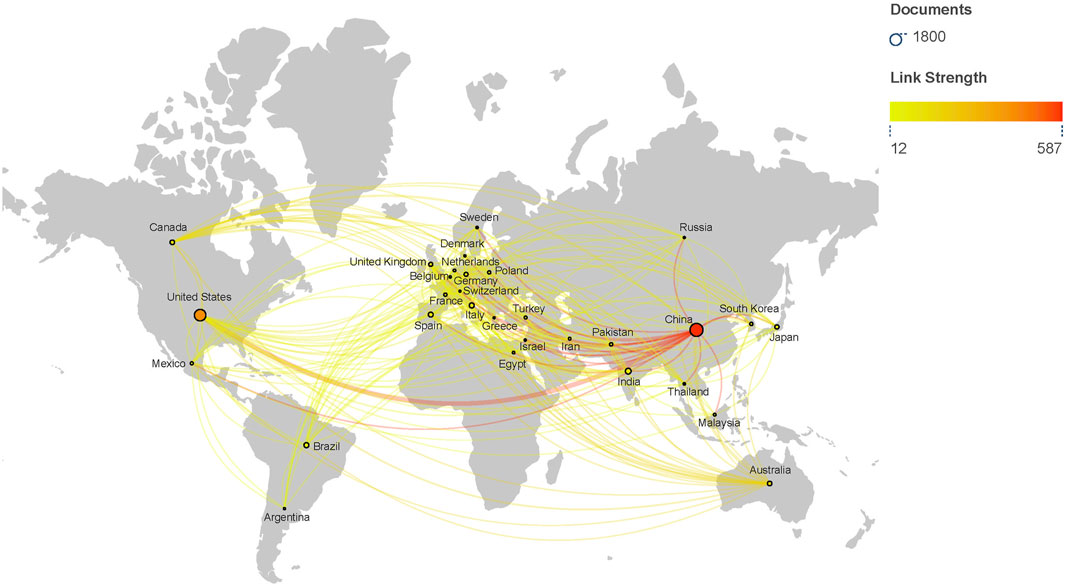
Figure 4. The co-authorship network map of countries. Node size, the publication count of each country. Connections between nodes, collaborations among countries. The color gradient from yellow to red, the strength of collaboration. Nodes closer to red, higher collaboration intensity. Nodes closer to yellow, lower collaboration intensity. Width of the connections between nodes, strength of collaboration. Wider connections, more frequent collaboration. Narrower connections, less frequent collaboration.
In addition to countries, a more granular understanding of the AMF research field can be obtained by analyzing the data related to institutions and authors. Table 4 lists the top 10 institutions in the field based on publication count. The top 10 institutions include six from China and four from the US. The Chinese Academy of Sciences (Beijing, China) was the institution that had the highest publication count. It contributed 334 articles, which comprised 5.80% of the total 5,760 articles. The second position was held by Northwest A&F University (Xianyang, China), with 314 articles that constituted 5.45%, and the third position was occupied by the United States Department of Agriculture (USDA) (DC, USA), with 238 articles that represented 4.13%. In terms of local average citation per paper, the institution that ranked first was Lanzhou University (Lanzhou, China), with an average citation of 47.48. The second position was held by the University of California (CA, USA) system, with an average citation of 41.28, and the third position was occupied by China Agricultural University (Beijing, China), with an average citation of 36.04.
To enhance the visualization of collaboration between institutions, a collaborative network map was created using CiteSpace. Figure 5A represents the collaborative network map among institutions. The map clearly shows that institutions with higher publication counts tend to collaborate more frequently with other institutions, such as the Chinese Academy of Sciences, Northwest A&F University, Ministry of Agriculture Rural Affairs (Beijing, China), and China Agricultural University. The Chinese Academy of Sciences exhibits a relatively high betweenness centrality (0.15), which indicates that there is substantial influence within this collaborative network. Thus, it serves as a significant entity that bridges collaborations with other institutions. While some institutions and companies may not have the highest publication counts, their publications are relatively high quality and have been highly cited at certain stages. Examples include the University of Alberta (Edmonton, Alberta, Canada), Dow Chemical Company (Midland, MI, USA), and Iowa State University (Ames, IA, USA). Figure 5B presents the burstiness information for the top 25 institutions, where burstiness reflects the attention an institution has received in this field. An examination of the temporal aspects showed that Gansu Agricultural University (Lanzhou, China), the University of Minnesota System (MN, USA), and the Gansu Academy of Agricultural Sciences (Lanzhou, China) have garnered considerable attention in recent years. The top three institutions that have the highest intensity of burstiness are the USDA, State University System of Florida (FL, USA), and the University of Granada (Granada, Spain). This suggests that these three institutions have attracted the most attention over the entire timeframe.
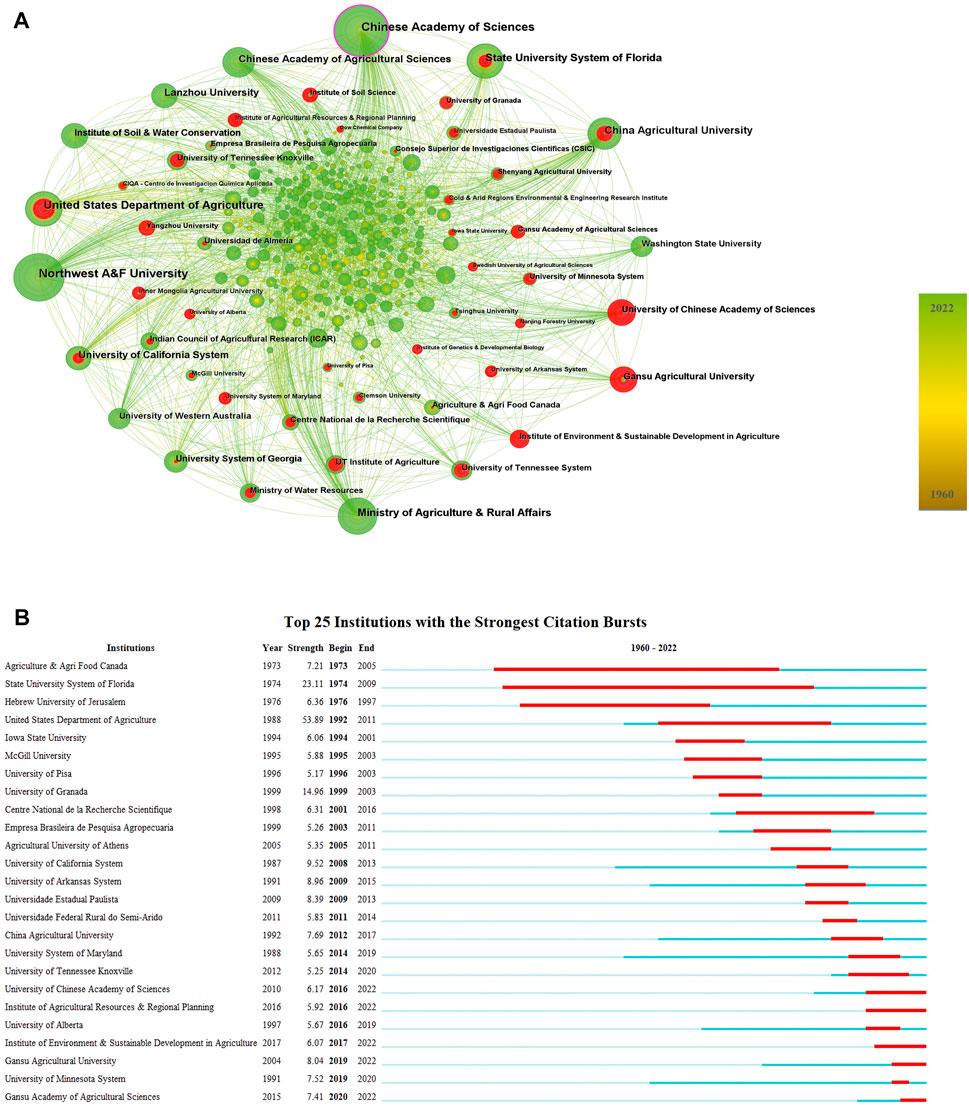
Figure 5. Co-occurrence analysis of the research institutions. (A) Node size, the publication count of each institution; color gradient, the publication time of the institutions. Closer proximity to deep yellow, earlier publication times; closer proximity to green, later publication times. Additionally, institutions highlighted in red signify periods of high citation impact. (B) The year indicates the time of the institution’s appearance, and the strength represents the intensity of the burst. Begin, year when the burst begins; End, year when the burst ends. Light blue bar, the institution has not yet burst onto the scene; dark blue bar, institutions are beginning to appear; red bar, period of the burst. A longer the red bar, the institution has been cited for a longer duration.
Table 5 displays the top 10 authors based on their publication count. In the 5,760 articles related to AMF research, there were 19,720 authors in total. Jia Zhikuan emerged as the most prolific author, with Li Fengmin and Kadambot H.M. Siddique ranked second and third, respectively. Among the top 10 authors, six are from China, which indicates that Chinese researchers have devoted significant attention and substantial contributions to the field of AMF on the international stage. The top three researchers have a relatively consistent focus on the theory and technology of dryland cultivation within the field of AMF research. This concentration underscores the importance of AMF for enhancing crop yields, particularly in arid regions. Clustering based on collaboration among the authors formed 10 smaller groups. The research group that is centered around Kadambot H.M. Siddique collaborated the most frequently and has emerged as a central cooperative entity in the AMF research field. The group of Li Fengmin is also a frequent collaborator with other groups, while that of Jia Zhikuan, although slightly larger, engages in relatively fewer collaborations. In the field of AMF, there are authors who have consistently focused on cultivating expertise, including Li Fengmin, Wang Dong, and Qin Ruijun among others. Additionally, emerging researchers, such as Chang Lei, Fan Junliang, Dong Qinge, and others, continually contribute to this field (Figure 6).
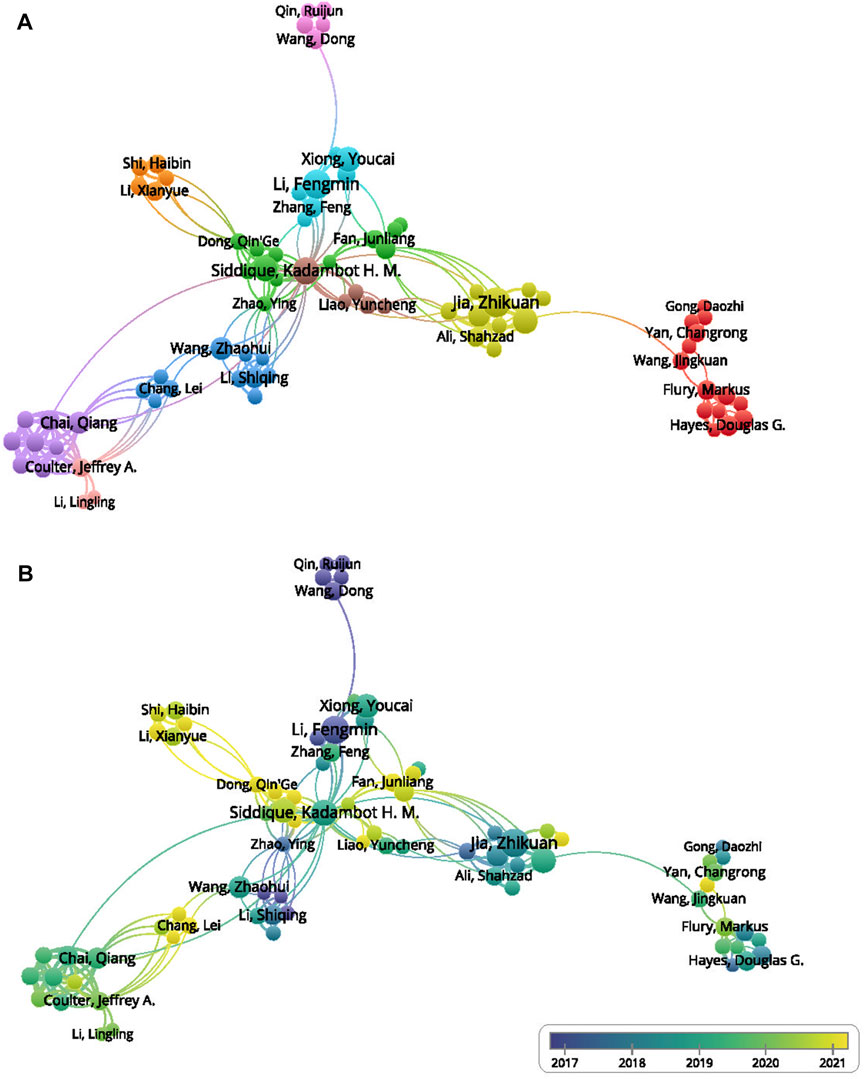
Figure 6. Research author cooperation map. (A) Nodes of the same color are grouped together and considered as a collaborative team, while different colors indicate different collaborative teams. (B) The color represents the average time of overall research for the nodes. The closer to yellow, the closer the average research time is to 2021, while the closer to purple, the closer the average research time is to 2017.
3.3 Analysis of the current research status
The frequency of keywords can reflect the current research dynamics and hot topics. From 1960 to 2022, the top 10 most frequently mentioned keywords in the entire time period were “Yield” (mentioned in 637 articles), “Growth” (576), “Soil” (466), “Degradation” (420), “Temperature” (382), “Water use efficiency” (382), “Management” (339), “Plastic mulch” (301), “Loess plateau” (290), and “Water” (268). Crop yield and growth are the primary focus, followed by efforts to improve the soil temperature and enhance the efficiency of utilizing water resources. Additionally, environmental concerns related to AMF are also receiving significant attention (Table 6; Figure 7). In 1956, AMF was discovered to increase the soil temperature, promote the growth and development of crops, and enable earlier harvesting (Clarkson, 1956). Research on the effects of AMF on other crops has gradually increased, which has continuously confirmed its role in increasing yields. Examples of crops that have benefitted from its use include sweet corn (Zea mays) (Miller and Bunger, 1963) and eggplant (Solanum melongena) (Pollack et al., 1969), cantaloupe (Cucumis melo var. cantalupensis) (Schales and Sheldrake Jr, 1966), chili pepper (Capsicum annuum) (Stephenson and Bergman, 1963), potato (S. tuberosum) (Henninger et al., 1977), tomato (Solanum lycopersicum) (Jones and Jones, 1978), cucumber (Cucumis sativa) (Paterson, 1980), summer squash (Cucurbita pepo) (Bhella and Kwolek, 1984), okra (Abelmoschus esculentus) (Brown et al., 1986), and watermelon (Citrullus lanatus) (Bhella, 1986) among others.
The keywords “Degradation,” “Management,” and “Plastic mulch” indicate that in the field of AMF, researchers are not only focusing on the advantages of AMF but also noting its drawbacks. The drawback of AMF lies in its primary material, which is non-degradable plastic. This type of plastic could potentially harm the environment. The primary components of AMF include polyvinyl chloride (PVC), polypropylene (PP), and PE that are polymers based on petroleum that are resistant to biological degradation. The amount of time it takes for them to degrade under natural conditions can potentially exceed 450 years. Residual AMF in the soil reduces the soil porosity, decreases soil moisture content, and increases the soil bulk density among others (Qi et al., 2020). Ultimately, in the form of microplastics, it returns to humans through in the form of microplastics that are absorbed by the plant, which pose a threat to human health (Li et al., 2020; Wang et al., 2022). In the 1970s, the concept of degradable plastics was introduced by countries, such as the US, which led to active research and development of biodegradable AMF (Otey et al., 1976). The promotion and application of biodegradable AMF holds promise for addressing the environmental pollution caused by conventional AMF (Liu et al., 2021).
The high frequency of the keyword “Loess plateau” indicates extensive application of AMF in this region. This is attributed to the location of Loess Plateau in a semi-arid to semi-humid climate zone, which experiences more rainfall in the summer and autumn and less in the winter and spring. The plateau faces severe soil erosion, which renders it an ecologically vulnerable and the key area of soil conservation in China. AMF helps to reduce the evaporation of soil moisture. Simultaneously, water moves from the deeper soil layers to the surface through capillary action and water vapor transport and maintains a relatively stable content of moisture in the surface soil. This alleviates water loss issues in the region to some extent. Moreover, solar energy penetrates the AMF, which heats the air and soil beneath. Owing to the greenhouse effect, heat is efficiently retained in the soil, which effectively raises the soil temperature and facilitates the successful overwintering of crops. The application and development of AMF in the cultivation of winter crops enables no-till practices in the autumn and spring. This helps to preserve the soil structure of the tillage layer and efficiently utilize the natural precipitation in the autumn. Simultaneously, it enhances vegetation cover in the autumn and spring, which reduces the sources of dust and contributes to the protection of environment (Wancang et al., 2006).
A timeline map of keywords can illustrate the temporal span and evolutionary history of clustered hotspots, which reveals the interrelatedness among these hotspots. It effectively reflects the overall research hotspots and evolutionary processes within a particular field. The timeline of AMF research from 1990 to 2022 is divided into three phases. There were 10 clusters from 1990 to 2000, six clusters from 2001 to 2011, and six clusters from 2012 to 2022. The number of keywords in each cluster and their co-occurrence increased over time. This indicates that with the annual development of the field of AMF field, the research directions have gradually become more focused, and the research has progressively deepened (Figures 8–10).
The clusters from 1990 to 2000 were as follows: #0 volatilization, #1 fresh market tomatoes, #2 behavior, #3 plants, #4 zea mays, #5 optimum range, #6 capsicum annuum, #7 soil solarization, #8 lycopersicon esculentum, and #9 transparent mulch. As shown in Figure 8, it is apparent that keywords, such as temperature in cluster #0, nitrogen in #1, growth in #3, soil in #4, yield in #5, polyethylene mulching in #7, and tomato in #9, receive significant attention.
Combined with the directions of the previous 10 clusters, this study deduced that in the first 11 years of the development of AMF, the primary focus was on increasing crop yield, with a particular emphasis on tomato, corn, and pepper as crops. Among these keywords, some reasons were discovered why AMF has developed into a widely used agricultural technology. AMF can create a micro-greenhouse effect on the soil surface, reduce the dissipation of soil heat, absorb solar radiation, retain heat, and increase the soil temperature to promote plant growth and development. This allows farmers to sow seeds early and extend their growing season. Transparent AMF can also be used for solarization because it covers the soil and utilizes solar radiation to increase the soil temperature to ones that are high enough to kill pathogens, thereby preventing plant diseases and promoting better crop growth (Stapleton, 1991; Orzolek, 2017). The keyword “volatilization” involves the issue of methyl bromide pollution. Methyl bromide is a volatile organic compound and serves as a versatile fumigant. In soil disinfection, methyl bromide is utilized to control fungi, bacteria, soilborne viruses, insects, mites, soil nematodes, rodents, parasitic seed plants, and weeds. Researchers have found that when fields are completely covered with high-density PE mulch film, 56%–73% of the methyl bromide used for soil fumigation is lost through atmospheric emissions (Wang and Yates, 1998). As early as 1992, methyl bromide was listed under the “Montreal Protocol on Substances that Deplete the Ozone Layer,” an international agreement to protect the stratospheric ozone layer. This designation prompted a focus on increasing the efficiency of utilizing methyl bromide and exploring substances and technologies as alternatives. Researchers have discovered that the use of high-barrier AMF reduces the emission of methyl bromide during soil disinfection compared with regular PE mulch film. Additionally, irrigation and deep injection also contribute to a reduction in the emissions of methyl bromide (Wang et al., 1997a; 1997b).
The key word optimum range relates to the technology related to floating mulch, which can provide favorable microclimate conditions and promote the growth and development of crops. Spanish researchers applied floating mulch technology to related crops (Chinese cabbage [Brassica rapa subsp. pekinensis] or potato) and calculated the optimum foliar ranges based on yields and measured the amounts of dry matter and trace elements (Baghour et al., 1999; Pulgar et al., 1999). Nitrogen keywords reflect the importance of fertilizer on crop growth and development. Nitrogen is found in a large number of compounds necessary for crop growth and directly affects the growth and yield of crops. Therefore, nitrogen fertilizer can greatly promote crop growth and development, while nitrogen fertilizer can stimulate the emission of nitrous oxide (N2O) in the soil, which causes a greenhouse effect. Therefore, an important issue is to design systems to reduce the emissions of N2O while applying nitrogen fertilizer. The use of AMF can promote the absorption of more nitrogen by plants, thereby increasing plant yield (JunZhu et al., 2014; Yang et al., 2015). However, the relationship between AMF and the emissions of N2O has been found to vary in different studies. Some studies have shown that covering the soil with AMF increases the emissions of N2O (Cuello et al., 2015; Kim et al., 2017; Lee et al., 2019), while others have not identified a significant impact on N2O emissions (Liu et al., 2014). Yet other research suggests a reduction in N2O emissions when AMF is used (Berger et al., 2013; Yu et al., 2018; Wang et al., 2021).
The clusters from 2001 to 2011 are as follows: #0 soil temperature, #1 biodegradation, #2 soil solarization, #3 water use efficiency, #4 volatilization, and #5 straw management (Figure 9). Compared with the clusters from 1990 to 2000, those from 2001 to 2011 retained the directions of soil solarization and volatilization and added four new directions, including soil temperature, biodegradation, water use efficiency, and straw management. The keyword growth of #0; degradation of #1; management of #2; yield, soil, temperature, nitrogen of #3; methyl bromide of #4; and water of #5 have attracted much attention in these 11 years. Compared with the previous 11 years, degradation, management, methyl bromide, and water are relatively new directions. This study will now analyze the relevant impact of the eight frontier keywords in the field of AMF research over these 11 years.
Owing to the ability of AMF to increase soil temperature and reduce the evaporation of water, it has been highly effective at increasing yields in areas that are at high altitudes and have low temperatures. Therefore, it is widely applied in crop production in arid, semi-arid, and semi-humid regions. The application of AMF in arid regions has correspondingly increased, particularly in areas with poor irrigation and low spring temperatures. For example, research has been conducted on the application of AMF on the Loess Plateau in China (Zhou et al., 2009). The application of AMF in arid regions has led to an increase in research articles related to keywords, such as soil temperature, water use efficiency, and water. The keywords “degradation” and “biodegradation” represent the solution to environmental pollution issues associated with AMF, namely, the use of biodegradable AMF to replace traditional PE mulch films. The keyword “biodegradation” first appeared as part of the 1990 to 2000 #0 volatilization cluster and is now presented as a separate cluster. From this, it can be deduced that, in addition to focusing on crop yield, the field of AMF research has become increasingly attentive to the environmental issues it generates. Consequently, there is a greater emphasis on the study of degradable AMF and the consideration of biodegradation as a primary solution. The essence of biodegradable AMF lies in biodegradable materials. There are many types of biodegradable materials, which can be divided into two categories based on their sources. One type is natural biodegradable high molecular weight materials, originating from nature, capable of natural decomposition with non-toxic byproducts, commonly including starch, cellulose, chitin, among others. The other type is artificially synthesized biodegradable materials, introducing ester-based structural units with degradation properties into aliphatic and aromatic polyester materials, such as polylactic acid (PLA), polycaprolactone (PCL), polyhydroxyalkanoate (PHA), polyhydroxybutyrate (PHB), and polybutylene adipate terephthalate (PBAT), among others, to achieve their degradation by microorganisms in nature (Qian et al., 2019). However, not all biodegradable materials are suitable for use in agricultural mulch films, and the performance of mulch films made from a single material often does not match that of films made from mixed materials. Currently, the most popular biodegradable mulch films include starch-based, PLA-based, PBAT-based, and PHA-based biodegradable mulch films. Owing to the intricate manufacturing procedures associated with biodegradable materials, the costs of biodegradable mulch films tend to be elevated. Consequently, amalgamating high-performance biodegradable materials with economically viable alternatives has emerged as a prevalent strategy. This approach not only meets the performance requirements of the mulch films but also helps to save costs (Akhir and Mustapha, 2022).
The keyword “straw management” in the cluster reflects a significant issue in the rice-wheat rotation in China and India, namely, the management of crop residues. The short turnover time between the planting and harvesting of rice and wheat makes it challenging for the crop residues to decompose and rot directly after they have been returned to the field. This leads to the untimely and inadequate treatment and utilization of crop straw. Incidents of large-scale on-site burning of straw occur, which results in significant losses of organic carbon and nitrogen, as well as severe air pollution. Some researchers have combined AMF with straw to form a double-layer film that covers the soil and replaces traditional flooding techniques. This approach can achieve yields that are essentially consistent with traditional flooding cultivation techniques, with a lower consumption of water. Additionally, it reduces the environmental problems caused by the burning of straw (Liu et al., 2005).
The keyword “Management” reflects the necessity of rational management for various agricultural technologies. AMF is just one agricultural technology. However, relying solely on AMF is insufficient to comprehensively promote the growth of crops and increase their yields. The integrated management of other agricultural technologies is necessary, which includes such methods as applying organic fertilizer, increasing crop cover, practicing crop rotation, using drip irrigation, implementing row covering, and using high tunnels and greenhouses. Only by combining and managing various agricultural technologies adaptively according to local conditions can crop growth be comprehensively promoted and crop yields increased. The keyword “methyl bromide” reflects an important environmental issue in agricultural production. Methyl bromide is considered to be a compound that depletes the ozone layer. Starting from 2005, the EU has banned its use, and it is gradually being phased out globally (Batchelor, 2002). Therefore, research on solarization and other fumigants has become a research hotspot. Fumigants are volatile organic compounds that form ground-level ozone when they react with nitrogen oxides in sunlight. Ozone is a strong oxidant, and high concentrations of ground-level ozone can harm humans, animals, crops, and other organisms. If there are high emissions of fumigants from the soil, fewer people will use them (Gao et al., 2008). Owing to considerations for environmental protection, research related to methyl bromide has become one of the hotspots in the field of study of AMF.
The clustering from 2012 to 2022 includes the following: #0 water use efficiency, #1 biodegradation, #2 nitrous oxide, #3 weed control, #4 microplastics, and #5 fruit quality. As shown in Figure 10, the hot keywords for these 11 years are #0 yield, growth, water use efficiency, temperature; #1 degradation, biodegradation; #2 nitrogen; #3 soil; #4 water, and #5 quality, performance. Compared to the previous 11 years, nitrous oxide (N2O), weed control, microplastics, fruit quality, quality, and performance are relatively novel directions. The following section will provide a detailed interpretation of these six key directions.
N2O was previously included in the content of nitrogen, but now as an independent cluster, it shows that researchers are paying more and more attention to environmental issues. N2O is a greenhouse gas, and understanding the impact of AMF on the emissions of N2O is crucial for the sustainable development of agriculture. However, there is currently no systematic decision on the influence of AMF cover on the emissions of N2O, and further related research is still merited. Weed control is crucial to reduce the competition for water and nutrients, minimize pest habitats, improve the feasibility of other field operations, enhance the aesthetics of farmland or orchards, and ultimately improve crop quality. Weed control is closely associated with AMF because most AMF can provide effective weed control over an extended period. However, the use of AMF reduces the options for soil fertility management (Hammermeister, 2016). In 2004, Thompson et al. published a paper that described the distribution of microplastic fragments in seawater (Thompson et al., 2004). Microplastics have received considerable attention from researchers. However, most studies have focused on microplastics in aquatic ecosystems. After weathering, PE mulch film can easily tear into small pieces and become microplastics. These microplastics are frequently absorbed or retained in agricultural soil, which increased the likelihood of broader land pollution. They may further contaminate terrestrial environments and contribute to ocean pollution through runoff (Jambeck et al., 2015; Brodhagen et al., 2017). Biodegradable AMF are considered a preferable alternative to traditional PE mulch films. However, the use of biodegradable AMF is also controversial. Some concerns include the high cost for agricultural purposes, and many materials only meet the standards for biodegradation standards under industrial composting conditions (Kasirajan and Ngouajio, 2012; Moreno et al., 2017). Reducing the cost of production of biodegradable AMF and ensuring their ability to undergo biodegradation in actual soil conditions are key research focuses in the field of AMF.
The keywords “fruit quality,” “quality,” and “performance” reflect a shift in the focus of research in the field of AMF. On the one hand, researchers have started to pay more attention to a variety of crops beyond the staple grains. Alternatively, researchers are not only concerned with increasing crop yields but are also placing greater emphasis on improving the quality of crops.
The improvement of fruit quality is a comprehensive task that is closely related to the healthy growth and development of plants. Therefore, AMF is often combined with other agricultural techniques, such as drip irrigation and high tunnels (Cowan et al., 2014; Li et al., 2017). As these technologies become more sophisticated and mature, the related research explores these topics in greater depth. Instead of just focusing on surface changes, researchers explored the internal mechanisms behind the enhancement of fruit quality. For example, Jiang et al. (2014) used silver-black reflective AMF to cover Ponkan tangerines (Citrus reticulata Blanco) and found a significant increase in the activities of the enzymes acid invertase and sucrose synthase (Jiang et al., 2014). Verena Overbeck et al. covered apples (Malus domestica) with reflective AMF and observed a notable increase in the content of flavonoids and anthocyanins in the fruit (Overbeck et al., 2013). Li Fan et al. used white AMF and discovered an improvement in the contents of phenolics and total antioxidant capacity of strawberries (Fragaria x ananassa) (Fan et al., 2012).
From the keyword analysis of AMF research from 2012 to 2022, two main aspects can be identified as the current state of research. First, there is a focus on applied research, which is aimed at enhancing crop yield and quality. Second, there is a research emphasis on improving the materials used for AMF to reduce their impact on the environment.
3.4 Analysis of research hotspots and frontiers
The repeated research directions over the years represent the established hotspots in the field, while emerging frontiers in recent years may potentially evolve into new directions and become new hotspots. The five hot keywords that appeared in all three stages from 1990 to 2022 that accounted for 16.1% compared with the total of 31 keywords included yield, growth, temperature, nitrogen, and soil (Figure 11). With the analysis of the five keywords and the previous keyword context, it is evident that enhancing soil temperature, increasing the absorption of nitrogen by crops, promoting crop growth and development, and improving crop yields are the hot topics of research in the field of AMF research. In the period from 2012 to 2022, six new keywords emerged, which accounted for 19.4% of the total. These keywords were fruit quality, weed control, microplastics, nitrous oxide, quality, and performance. This enabled the deduction that the frontier directions in the field of AMF research primarily focus on two aspects. One is the improvement of fruit and crop quality, and the other is environmental protection. Soil microplastic residues and emissions of N2O from the soil are receiving significant attention. Reducing the costs of production of biodegradable AMF, ensuring the biodegradation capability of biodegradable AMF in actual soil, enhancing crop nitrogen absorption, and reducing the soil emissions of N2O and other greenhouse gases are the main directions for future research.
In addition to keywords, the hot research in this field can also be explored by examining the highly cited papers in this field. Table 7 shows the top 10 most cited papers in the field. The most commonly cited paper is by Jay M. Ham and entitled “Optical Properties of Plastic Mulches Affect the Field Temperature Regime.” The paper, which has been cited 129 times in local data, examined the optical properties of eight different types of plastic mulches and their effects on the soil and air temperatures. They found that different types of plastic mulches absorb and reflect light differently, which affects heating of the soil. Results suggest that conduction of heat between the plastic and the soil surface also affects the extent of soil heating in a mulched field. (Ham et al., 1993). The second most highly cited paper was by William J. Lamont and was entitled “Plastics: Modifying the Microclimate for the Production of Vegetable Crops.” This paper elaborates several important contents of plasticulture. Examples include plastic-covered greenhouses, plastic mulches, row covers, high tunnels, and windbreaks (Lamont, 2005). The third most highly cited paper was “Microclimate Modification with Plastic Mulch,” by Julie M. Tarara, which reviewed previous research on plastic mulch and improved the techniques for monitoring crop microclimates. It provides new data to demonstrate the effect of black AMF on the plant microclimate (Tarara, 2000). By integrating the specific content of the first three papers and detailed information from Table 7, we can observe that the attention of researchers in the field of AMF is concentrated on its impact on soil climate and the improvement of crop yields in arid regions.
In summary, altering soil microclimates, promoting crop growth and development, and increasing crop yields constitute the hotspots of research in the field of AMF. Enhancing crop quality and mitigating environmental pollution issues associated with AMF represent the frontier directions in this research field.
4 Conclusion and perspectives
This study conducted a bibliometric review of the AMF field, which offers an overview and detailed insights into past, current, and future research trends. The number of publications in the AMF field has been consistently increasing, which demonstrates the growing interest of researchers throughout the world. The majority of these studies are dedicated to horticulture and environmental science, with the key sources of research found in journals, such as Agricultural Water Management, HortScience, Science of The Total Environment and others. Jia Zhikuan, Li Fengmin, and Kadambot H. M. Siddique emerged as the top three authors in terms of the quantities of publications. Most authors in the field of AMF concentrate their research on the theory and technology of cultivation in arid regions. The top three institutions in terms of publication volume are the Chinese Academy of Sciences, Northwest A&F University, and the USDA. Among the top 10 institutions in publication quantity, all are from China and the US, which underscores the significance of China and the US in the field of AMF research. The top three countries with the highest output of publications are China, the US, and India. China, the US, Australia, and Canada are the primary countries that collaborate, while Europe constitutes a group of nations engaged in AMF research and serves as a primary collaborative partner for other countries. The current research status in the field of AMF primarily focuses on two aspects. First, there is applied research aimed at enhancing the yield and quality of crops. Second, there is research dedicated to improving the material of AMF to minimize their environmental impact. The hot research topics in the field of AMF primarily involve altering the soil micro-climates and promoting crop growth and development, which ultimately leads to increased crop yields. An analysis of the forefront suggests that the primary future research directions in this field revolve around two aspects. First, there is a focus on enhancing crop quality and investigating the internal mechanisms behind quality improvement. Second, there is an emphasis on protecting the environment, with notable attention given to soil microplastic residues and the emissions of nitrous oxide (N2O). The primary directions for addressing future environmental issues include lowering the cost of producing biodegradable AMF, improving their ability to biodegrade in actual soil, enhancing crop nitrogen absorption, and reducing the soil emissions of greenhouse gases.
Author contributions
KW: Data curation, Formal Analysis, Methodology, Visualization, Writing–original draft. TJ: Project administration, Supervision, Writing–review and editing. BW: Data curation, Formal Analysis, Visualization, Writing–original draft. ZY: Funding acquisition, Supervision, Writing–review and editing. KP: Project administration, Supervision, Writing–review and editing. YH: Supervision, Writing–review and editing, Project administration.
Funding
The author(s) declare that financial support was received for the research, authorship, and/or publication of this article. This research was funded by Special Funds for Construction of Innovative Provinces in Hunan Province, grant number 2021NK1011.
Conflict of interest
The authors declare that the research was conducted in the absence of any commercial or financial relationships that could be construed as a potential conflict of interest.
Publisher’s note
All claims expressed in this article are solely those of the authors and do not necessarily represent those of their affiliated organizations, or those of the publisher, the editors and the reviewers. Any product that may be evaluated in this article, or claim that may be made by its manufacturer, is not guaranteed or endorsed by the publisher.
References
Akhir, M. A. M., and Mustapha, M. (2022). Formulation of biodegradable plastic mulch film for agriculture crop protection: a review. Polym. Rev. 62, 890–918. doi:10.1080/15583724.2022.2041031
Baghour, M., Moreno, D., Hernández, J., Castilla, N., and Romero, L. (1999). Optimum range in leaves of potato grown under plastic mulches: III. Micronutrients. Phyt. J. Exp. Bot. 64, 79–82. doi:10.5555/20013027367
Batchelor, T. (2002). “International and European community controls on methyl bromide and the status of methyl bromide use and alternatives in the European Community,” in Proceedings of international conference on alternatives to methyl bromide œ, 37.
Berger, S., Kim, Y., Kettering, J., and Gebauer, G. (2013). Plastic mulching in agriculture—friend or foe of N2O emissions? Agric. Ecosyst. Environ. 167, 43–51. doi:10.1016/j.agee.2013.01.010
Bhella, H. S. (1986). “Watermelon growth, yield, and nutrition as influenced by plastic mulch and trickle irrigation,” in Proceedings of the 19th National agricultural plastics congress (USA), 295–301.
Bhella, H. S., and Kwolek, W. F. (1984). The effects of trickle irrigation and plastic mulch on zucchini. horts 19, 410–411. doi:10.21273/HORTSCI.19.3.410
Brodhagen, M., Goldberger, J. R., Hayes, D. G., Inglis, D. A., Marsh, T. L., and Miles, C. (2017). Policy considerations for limiting unintended residual plastic in agricultural soils. Environ. Sci. Policy 69, 81–84. doi:10.1016/j.envsci.2016.12.014
Brown, J., Lewis, G., and Bryce, H. (1986). “Influence of black plastic mulch and row covers on the growth and performance of okra intercropped with turnip greens,” in Proceedings of the National agricultural plastics congress.
Clarkson, V. (1956). “Effect of paper and polyethylene mulches and plastic caps on cantaloupe yields and earliness,” in American society for horticultural science, 400–404.
Cowan, J. S., Miles, C. A., Andrews, P. K., and Inglis, D. A. (2014). Biodegradable mulch performed comparably to polyethylene in high tunnel tomato (Solanum lycopersicum L.) production. J. Sci. Food Agric. 94, 1854–1864. doi:10.1002/jsfa.6504
Cuello, J. P., Hwang, H. Y., Gutierrez, J., Kim, S. Y., and Kim, P. J. (2015). Impact of plastic film mulching on increasing greenhouse gas emissions in temperate upland soil during maize cultivation. Appl. Soil Ecol. 91, 48–57. doi:10.1016/j.apsoil.2015.02.007
de Castilhos Ghisi, N., Zuanazzi, N. R., Fabrin, T. M. C., and Oliveira, E. C. (2020). Glyphosate and its toxicology: a scientometric review. Sci. Total Environ. 733, 139359. doi:10.1016/j.scitotenv.2020.139359
Domagała-Świątkiewicz, I., and Siwek, P. (2013). The effect of direct covering with biodegradable nonwoven film on the physical and chemical properties of soil. Pol. J. Environ. Stud. 22, 3.
Fan, L., Dubé, C., Fang, C., Roussel, D., Charles, M. T., Desjardins, Y., et al. (2012). Effect of production systems on phenolic composition and oxygen radical absorbance capacity of ‘Orléans’ strawberry. LWT - Food Sci. Technol. 45, 241–245. doi:10.1016/j.lwt.2011.09.004
Gao, S., Trout, T. J., and Schneider, S. (2008). Evaluation of fumigation and surface seal methods on fumigant emissions in an orchard replant field. J. Environ. Qual. 37, 369–377. doi:10.2134/jeq2007.0088
Ham, J. M., Kluitenberg, G. J., and Lamont, W. J. (1993). Optical properties of plastic mulches affect the field temperature Regime. J. Am. Soc. Hortic. Sci. 118, 188–193. doi:10.21273/JASHS.118.2.188
Hammermeister, A. M. (2016). Organic weed management in perennial fruits. Sci. Hortic. 208, 28–42. doi:10.1016/j.scienta.2016.02.004
Henninger, M. R., Paterson, J. W., and Smith, N. (1977). Influence of slitted polyethylene mulch, nitrogen rates, and trickle irrigation on potatoes. Am. Potato J. 54, 261–270. doi:10.1007/BF02849874
Jambeck, J. R., Geyer, R., Wilcox, C., Siegler, T. R., Perryman, M., Andrady, A., et al. (2015). Plastic waste inputs from land into the ocean. Science 347, 768–771. doi:10.1126/science.1260352
Jayasekara, R., Harding, I., Bowater, I., and Lonergan, G. (2005). Biodegradability of a selected range of polymers and polymer blends and standard methods for assessment of biodegradation. J. Polym. Environ. 13, 231–251. doi:10.1007/s10924-005-4758-2
Jiang, N., Jin, L.-F., Teixeira da Silva, J. A., Islam, M. Z., Gao, H.-W., Liu, Y.-Z., et al. (2014). Activities of enzymes directly related with sucrose and citric acid metabolism in citrus fruit in response to soil plastic film mulch. Sci. Hortic. 168, 73–80. doi:10.1016/j.scienta.2014.01.021
Jones, U. S., and Jones, T. L. (1978). Influence of polyethylene mulch and magnesium salts on tomatoes growing on loamy sand. Soil Sci. Soc Amer J 42, 918–922. doi:10.2136/sssaj1978.03615995004200060018x
JunZhu, G., ShuYa, L., XinYue, Z., GuoYin, Y., Ying, X., ShaoYang, T., et al. (2014). Effects of nitrogen application and film mulching on yield performance parameters and nitrogen use efficiency of spring maize in the Middle Reaches of Yangtze River. Acta Agron. Sin. 40, 1081–1092. doi:10.3724/SP.J.1006.2014.01081
Kahraman, C., Cayli, G., and Erturk, E. (2022). Sound agricultural practices in Turkey: environmental impact on the enhancement of soil fertility. FRESENIUS Environ. Bull. 31, 8322–8327.
Kasirajan, S., and Ngouajio, M. (2012). Polyethylene and biodegradable mulches for agricultural applications: a review. Agron. Sustain. Dev. 32, 501–529. doi:10.1007/s13593-011-0068-3
Kim, G. W., Das, S., Hwang, H. Y., and Kim, P. J. (2017). Nitrous oxide emissions from soils amended by cover-crops and under plastic film mulching: fluxes, emission factors and yield-scaled emissions. Atmos. Environ. 152, 377–388. doi:10.1016/j.atmosenv.2017.01.007
Lamont, W. J. (2005). Plastics: modifying the microclimate for the production of vegetable crops. HortTechnology 15, 477–481. doi:10.21273/HORTTECH.15.3.0477
Lee, J. G., Cho, S. R., Jeong, S. T., Hwang, H. Y., and Kim, P. J. (2019). Different response of plastic film mulching on greenhouse gas intensity (GHGI) between chemical and organic fertilization in maize upland soil. Sci. Total Environ. 696, 133827. doi:10.1016/j.scitotenv.2019.133827
Li, L., Luo, Y., Li, R., Zhou, Q., Peijnenburg, W. J. G. M., Yin, N., et al. (2020). Effective uptake of submicrometre plastics by crop plants via a crack-entry mode. Nat. Sustain 3, 929–937. doi:10.1038/s41893-020-0567-9
Li, X., Šimůnek, J., Shi, H., Yan, J., Peng, Z., and Gong, X. (2017). Spatial distribution of soil water, soil temperature, and plant roots in a drip-irrigated intercropping field with plastic mulch. Eur. J. Agron. 83, 47–56. doi:10.1016/j.eja.2016.10.015
Liu, E., Zhang, L., Dong, W., and Yan, C. (2021). Biodegradable plastic mulch films in agriculture: feasibility and challenges. Environ. Res. Lett. 16, 011004. doi:10.1088/1748-9326/abd211
Liu, J., Zhu, L., Luo, S., Bu, L., Chen, X., Yue, S., et al. (2014). Response of nitrous oxide emission to soil mulching and nitrogen fertilization in semi-arid farmland. Agric. Ecosyst. Environ. 188, 20–28. doi:10.1016/j.agee.2014.02.010
Liu, X., Ai, Y., Zhang, F., Lu, S., Zeng, X., and Fan, M. (2005). Crop production, nitrogen recovery and water use efficiency in rice–wheat rotation as affected by non-flooded mulching cultivation (NFMC). Nutr. Cycl. Agroecosyst 71, 289–299. doi:10.1007/s10705-004-6801-4
Ma, C., Su, H., and Li, H. (2021). Global research trends on prostate diseases and erectile dysfunction: a bibliometric and visualized study. Front. Oncol. 10, 627891. doi:10.3389/fonc.2020.627891
Menossi, M., Salcedo, F., Capiel, J., Adler, M., Alvarez, V. A., and Ludueña, L. N. (2022). Effect of starch initial moisture on thermoplastic starch film properties and its performance as agricultural mulch film. J. Polym. Res. 29, 285. doi:10.1007/s10965-022-03150-y
Miller, D. E., and Bunger, Wm. C. (1963). Use of plastic soil covers in sweet corn production 1. Agron. J. 55, 417–419. doi:10.2134/agronj1963.00021962005500050001x
Moreno, M. M., González-Mora, S., Villena, J., Campos, J. A., and Moreno, C. (2017). Deterioration pattern of six biodegradable, potentially low-environmental impact mulches in field conditions. J. Environ. Manag. 200, 490–501. doi:10.1016/j.jenvman.2017.06.007
Orzolek, M. (2017). A guide to the manufacture, performance, and potential of plastics in agriculture. Elsevier.
Otey, F. H., Westhoff, R. P., and Russell, C. R. (1976). Starch graft copolymers-degradable fillers for poly(vinyl chloride) plastics. Product. R&D 15, 139–142. doi:10.1021/i360058a008
Overbeck, V., Schmitz-Eiberger, M. A., and Blanke, M. M. (2013). Reflective mulch enhances ripening and health compounds in apple fruit. J. Sci. Food Agric. 93, 2575–2579. doi:10.1002/jsfa.6079
Paterson, J. (1980). Fertilizing mulched and unmulched cucumbers. Proc. 15th Natl. Agric. Plast. Congr., 97–99.
Pollack, B., Smith, N., and Cialone, J. (1969). A summary of crop response to various agricultural film mulches. Proc. 9th Natl. Agri. Plast. Congr., 17–25.
Pulgar, G., Moreno, D., Hernández, J., Castilla, N., and Romero, L. (1999). Optimum range of macronutrients in Chinese cabbage (Brassica pekinensis [Lour] Rupr. cv. Nagaoka 50) grown under floating mulch. Phyt. J. Exp. Bot. 64, 23–26. doi:10.5555/20013027345
Qi, R., Jones, D. L., Li, Z., Liu, Q., and Yan, C. (2020a). Behavior of microplastics and plastic film residues in the soil environment: a critical review. Sci. Total Environ. 703, 134722. doi:10.1016/j.scitotenv.2019.134722
Qi, Y., Beriot, N., Gort, G., Huerta Lwanga, E., Gooren, H., Yang, X., et al. (2020b). Impact of plastic mulch film debris on soil physicochemical and hydrological properties. Environ. Pollut. 266, 115097. doi:10.1016/j.envpol.2020.115097
Qian, D., Jia, Yu, Jiang, X., and Zhu, H. (2019). Research progress on biodegradable mulching film materials. Eng. Plast. Appl. 47, 150–153. doi:10.3969/j.issn.1001-3539.2019.12.028
Schales, F. D., and Sheldrake Jr, R. (1966). “Mulch effects on soil conditions and muskmelon response,” in Proc. Amer. Soc. Hort. Sci, 425–430.
Sintim, H. Y., and Flury, M. (2017). Is biodegradable plastic mulch the solution to agriculture’s plastic problem? Environ. Sci. Technol. 51, 1068–1069. doi:10.1021/acs.est.6b06042
Somanathan, H., Sathasivam, R., Sivaram, S., Mariappan Kumaresan, S., Muthuraman, M. S., and Park, S. U. (2022). An update on polyethylene and biodegradable plastic mulch films and their impact on the environment. Chemosphere 307, 135839. doi:10.1016/j.chemosphere.2022.135839
Stapleton, J. (1991). “Use of soil solarization for the control of soil pests,” in Proceedings of the national agricultural plastics congress (USA).
Steinmetz, Z., Wollmann, C., Schaefer, M., Buchmann, C., David, J., Tröger, J., et al. (2016). Plastic mulching in agriculture. Trading short-term agronomic benefits for long-term soil degradation? Sci. Total Environ. 550, 690–705. doi:10.1016/j.scitotenv.2016.01.153
Stephenson, K., and Bergman, E. (1963). Some mechanical and cultural developments on the Penn State transplanter mulcher. Proc. 4th Natl. Agric. Plast. Congr., 58–64.
Sun, Y., Yang, W., Shi, H., Tanveer, S. K., and Hai, J. (2022). Past, present, and future perspectives of biodegradable films for soil: a 30-year systematic review. Front. Bioeng. Biotechnol. 10, 1006388. doi:10.3389/fbioe.2022.1006388
Tarara, J. M. (2000). Microclimate modification with plastic mulch. HortSci 35, 169–180. doi:10.21273/HORTSCI.35.2.169
Thompson, R. C., Olsen, Y., Mitchell, R. P., Davis, A., Rowland, S. J., John, A. W. G., et al. (2004). Lost at sea: where is all the plastic? Science 304, 838. doi:10.1126/science.1094559
Wancang, S., Junyi, N., and Wenhui, T. (2006). The effects of covering on wintersurvival and yield of winter rapeseed. Chinese Journal of Oil Crop Sciences, 315–318.
Wang, D., and Yates, S. R. (1998). Methyl bromide emission from fields partially covered with a high-density polyethylene and a virtually impermeable film. Environ. Sci. Technol. 32, 2515–2518. doi:10.1021/es980056h
Wang, D., Yates, S. R., Ernst, F. F., Gan, J., Gao, F., and Becker, J. O. (1997a). Methyl bromide emission reduction with field management practices. Environ. Sci. Technol. 31, 3017–3022. doi:10.1021/es970275n
Wang, D., Yates, S. R., Ernst, F. F., Gan, J., and Jury, W. A. (1997b). Reducing methyl bromide emission with a high barrier plastic film and reduced dosage. Environ. Sci. Technol. 31, 3686–3691. doi:10.1021/es970420x
Wang, F., Feng, X., Liu, Y., Adams, C. A., Sun, Y., and Zhang, S. (2022). Micro (nano) plastics and terrestrial plants: up-to-date knowledge on uptake, translocation, and phytotoxicity. Resour. Conservation Recycl. 185, 106503. doi:10.1016/j.resconrec.2022.106503
Wang, T., Li, H.-M., Wen, B.-Y., Panneerselvam, R., Zhang, Y.-J., Wang, A., et al. (2023). Au nanocakes as a SERS sensor for on site and ultrafast detection of dioxins. Vib. Spectrosc. 126, 103518. doi:10.1016/j.vibspec.2023.103518
Wang, W., Han, L., Zhang, X., and Wei, K. (2021). Plastic film mulching affects N2O emission and ammonia oxidizers in drip irrigated potato soil in northwest China. Sci. Total Environ. 754, 142113. doi:10.1016/j.scitotenv.2020.142113
Yang, H., Yang, B., Dai, Y., Xu, M., Koide, R. T., Wang, X., et al. (2015). Soil nitrogen retention is increased by ditch-buried straw return in a rice-wheat rotation system. Eur. J. Agron. 69, 52–58. doi:10.1016/j.eja.2015.05.005
Yu, Y., Jia, H., and Zhao, C. (2018). Evaluation of the effects of plastic mulching and nitrapyrin on nitrous oxide emissions and economic parameters in an arid agricultural field. Geoderma 324, 98–108. doi:10.1016/j.geoderma.2018.03.012
Zhang, G. S., Hu, X. B., Zhang, X. X., and Li, J. (2015). Effects of plastic mulch and crop rotation on soil physical properties in rain-fed vegetable production in the mid-Yunnan plateau, China. Soil Tillage Res. 145, 111–117. doi:10.1016/j.still.2014.09.010
Zhou, L., Yasmine, A., Jiang, Z., Yu, Z., and Qu, J. (2022). Microplastics: a review on biological effects, analysis and degradation methods. Prog. Chem. 34, 1935–1946. doi:10.7536/PC211226
Keywords: agricultural mulch film, soil pollution, bibliometrics, CiteSpace, VOSviewer
Citation: Wang K, Jin T, Wang B, Yuan Z, Peng K and Hu Y (2024) Evolution of hotspots and research trends in agricultural mulch film research: a bibliometric review. Front. Environ. Sci. 12:1394808. doi: 10.3389/fenvs.2024.1394808
Received: 04 March 2024; Accepted: 03 April 2024;
Published: 26 April 2024.
Edited by:
Sudhir Kumar Pandey, Guru Ghasidas Vishwavidyalaya, IndiaReviewed by:
Fayuan Wang, Qingdao University of Science and Technology, ChinaSaowapa Chaiwong, Mae Fah Luang University, Thailand
Copyright © 2024 Wang, Jin, Wang, Yuan, Peng and Hu. This is an open-access article distributed under the terms of the Creative Commons Attribution License (CC BY). The use, distribution or reproduction in other forums is permitted, provided the original author(s) and the copyright owner(s) are credited and that the original publication in this journal is cited, in accordance with accepted academic practice. No use, distribution or reproduction is permitted which does not comply with these terms.
*Correspondence: Yuan Hu, hy410302@163.com; Zheming Yuan, zhmyuan@sina.com
†These authors share first authorship
 Kuaishun Wang
Kuaishun Wang Tuo Jin2,3†
Tuo Jin2,3†  Zheming Yuan
Zheming Yuan

